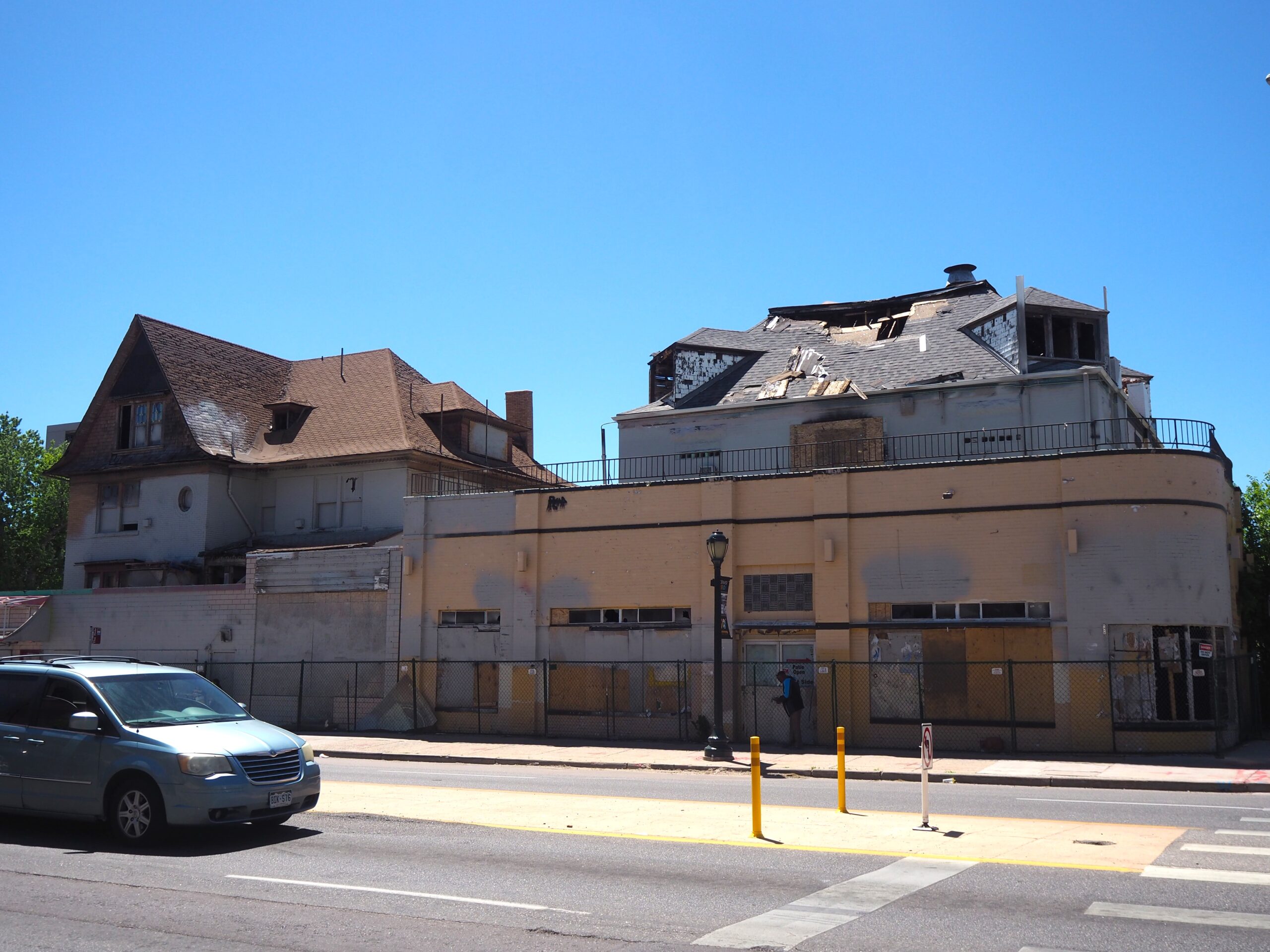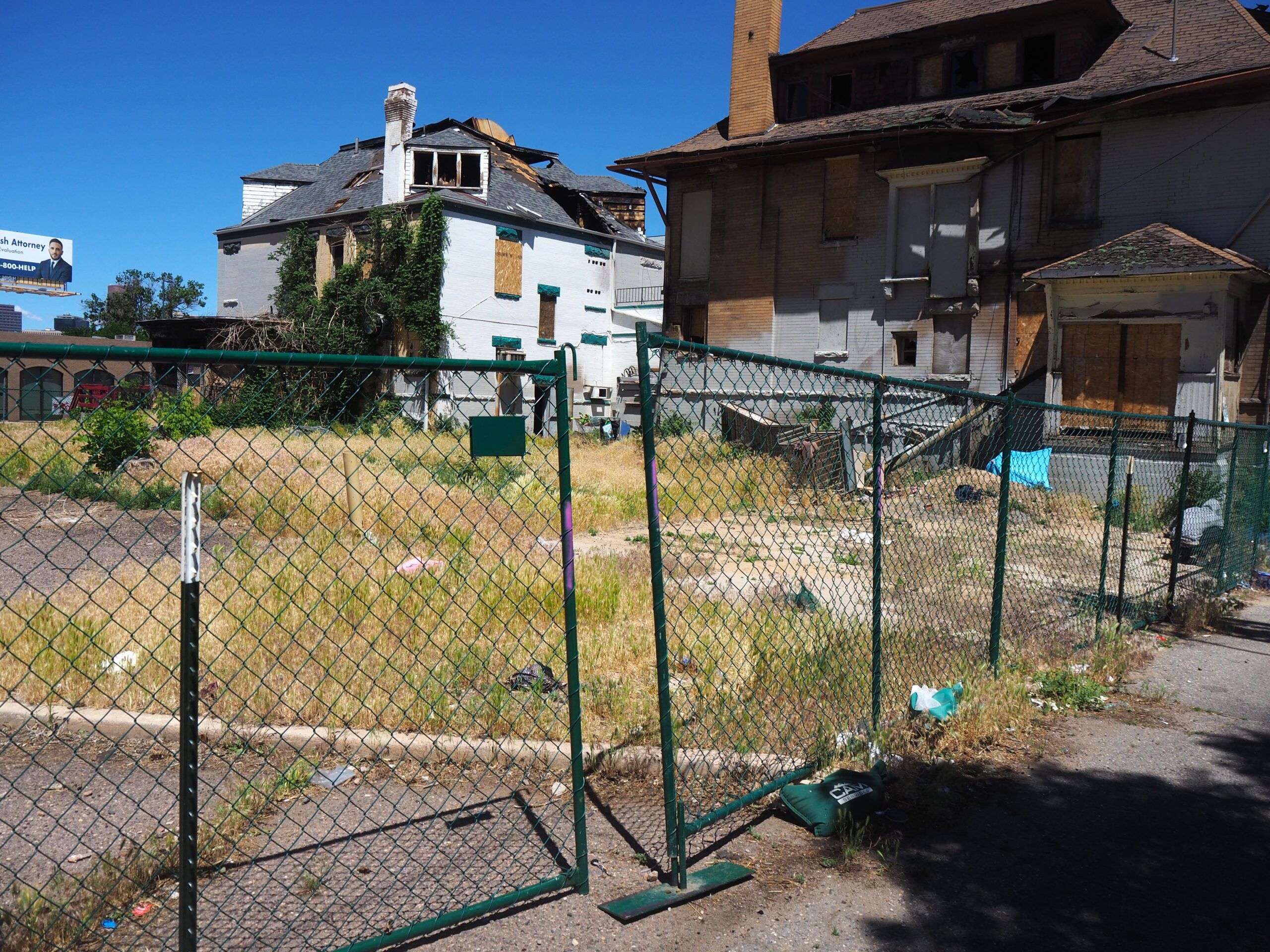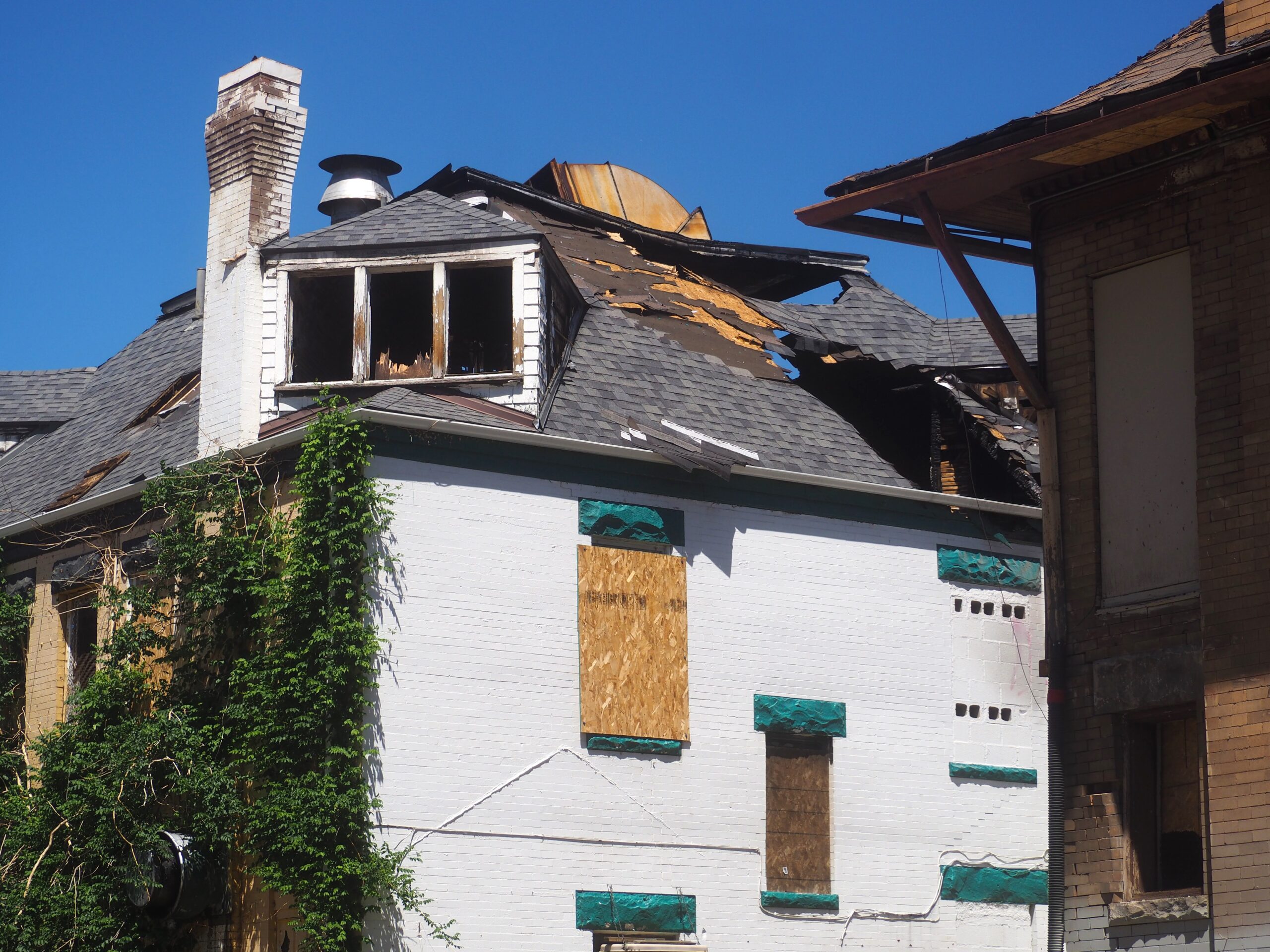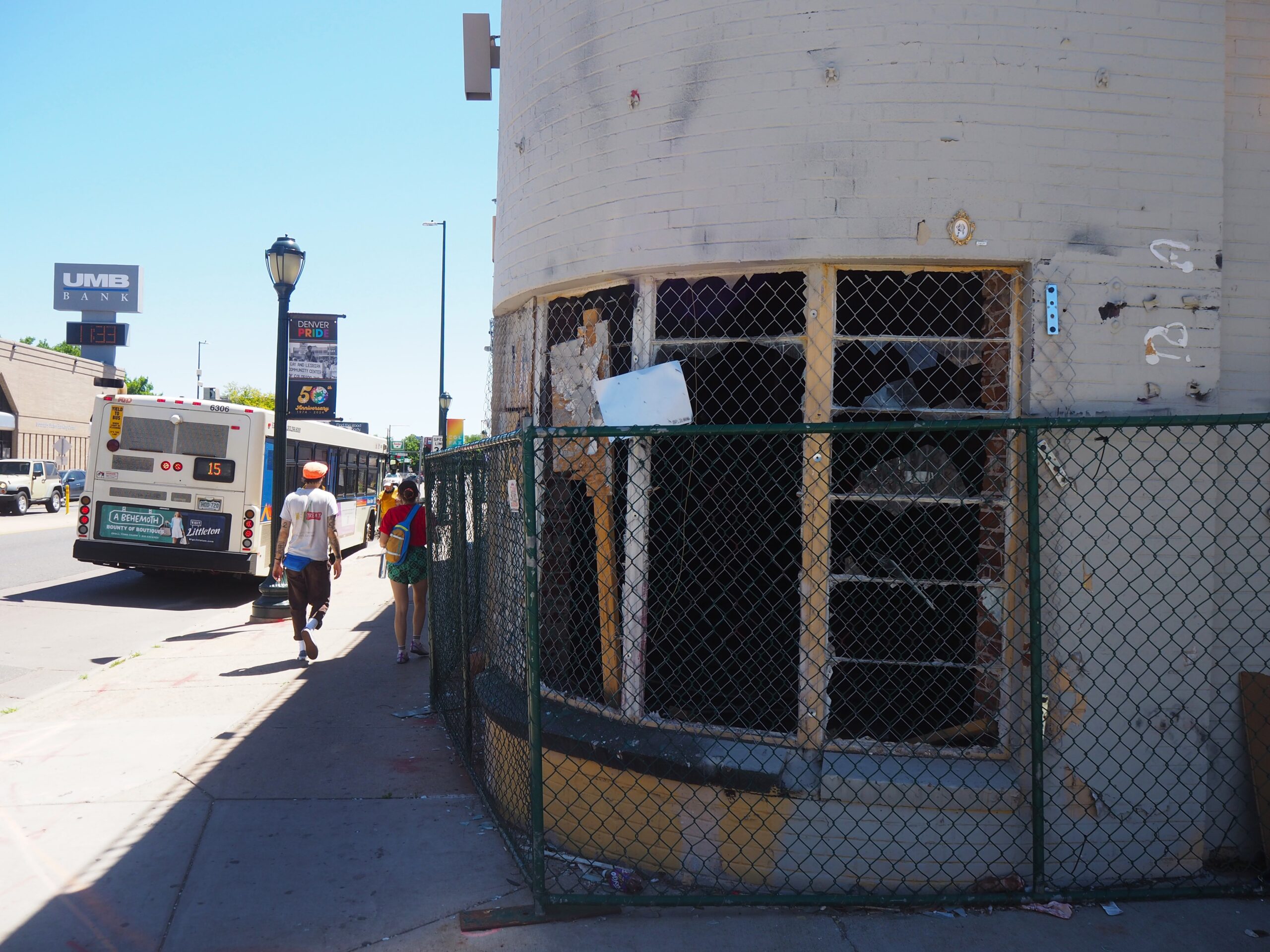
The owner of the connected buildings at 1600 and 1618 E. Colfax Ave. in Denver wants to tear them down, but was denied approval to do so this week. (Thomas Gounley/BusinessDen)
On March 13, a local developer’s long-planned bid to redevelop a site along Colfax Avenue went up in flames — literally.
Kiely Wilson, whose firm Pando Holdings owns the buildings at 1600 and 1618 E. Colfax Ave., learned of the fire there from a neighbor around 1:30 p.m. that day, he said. The Denver Fire Department has not completed its investigation, but Wilson told BusinessDen a department official on site that day said it was started by someone who broke into one of the boarded-up buildings.
Homeless squatters have been doing that for years.
“There has been a non-stop pattern of unauthorized individuals trespassing, breaking into the buildings and camping,” Lance Gutsch, Wilson’s business partner, said at a Tuesday city meeting.

Kiely Wilson
Denver-based Pando bought the two buildings in 2017, paying $3.2 million for them and a parking lot to the rear, records show. A plan was hatched to fix up the haphazard-looking structures — basically old mansions with storefronts added in front — and construct a seven-story apartment building on the undeveloped land behind them.
Fifteen days after the fire, Denver’s chief building official told Pando in a letter that it had left the buildings “unsafe,” and that the firm had until late June to get a permit to demolish or repair them.
Pando decided demolition would be best.
And on Tuesday, Wilson and Gutsch watched a city commission twice reject their requests for the demolition permit.
“We’re kind of at our wit’s end, honestly,” Wilson said after the first of the two votes. “We hear it from our neighbors. We hear it from the police.”

A break in the fence surrounding the buildings at 1600 and 1618 E. Colfax Ave. on Wednesday, June 5. (Thomas Gounley/BusinessDen)
The votes took place because Pando’s structures are part of the Wyman Historic District, one of 60 historic districts designated by the city. The Wyman district covers an area generally east of Cheesman Park. Changes to the exterior of structures determined to be “contributing” to the district must be approved by Denver’s Landmark Preservation Commission.
The historic status is why, before the fire, Pando planned to renovate the 1600 and 1618 E. Colfax structures. Getting approval to demolish a contributing structure is very difficult — the whole point of a historic district is preservation.
But Pando had supporters at Tuesday’s meeting. Neighbors said the buildings are a magnet for vice.
“I’m a regular caller of 311 and 911,” said Van Schoales, who lives across the alley. “The number of crimes taking place because of these properties not being developed is off the charts.”
Scott McAllister, who also lives nearby, said he tries to avoid having visitors in town go by the buildings, which have become “a huge detractor” to the neighborhood.
“This feels not just necessary, but the only reasonable decision,” he said of demolition.

The structures have holes in the roof. (Thomas Gounley/BusinessDen)
Multiple people said they had been advocates of renovating the 1600 and 1618 buildings originally. But Brad Cameron, the president of a local neighborhood association — who once unsuccessfully sought to mandate preservation of Denver7’s building at Speer and Lincoln — said “sometimes circumstances are such that it’s necessary to let go of the past and move forward.”
“Let’s face it, we’re not dealing with the Notre Dame Cathedral,” he said, referencing the French landmark being rehabbed after a 2019 fire.
The sole member of the public pushing back against demolition at Tuesday’s meeting was John Deffenbaugh, the CEO of Historic Denver, a preservation-focused nonprofit.
Deffenbaugh noted the 1600 building was once home to architect George Williamson, who designed nearby East High School. He said what Pando was really doing was “seeking demolition through neglect.”
Deffenbaugh noted that the former Tom’s Diner building, which is 10 blocks to the west, is also vacant. He said it hasn’t had the same issue with break-ins.
“I’d argue that Tom’s Diner is an example of a building that’s securely safeguarded while it’s empty right now,” he said. “At Tom’s Diner, the lights are on. Someone visits there at least once a day. Its fence is very secure.”
Pando’s Gutsch and Wilson had acknowledged that conditions deteriorated under their ownership. Things got particularly challenging when the pandemic arrived, they said, and their tenants in the buildings moved out. Visible homelessness around Denver surged. But they’d boarded up the buildings, and installed cameras and fencing.
Nevertheless, the pair said, people repeatedly tresspassed. The cops were called to get them out. A contractor was called to fix the damage. Then, they said, the cycle would repeat itself.
Cameron, with Neighbors for Greater Capitol Hill, defended Pando, saying the buildings “were in absolutely terrible condition” even before the firm bought them.
“I think they really did try to keep the building secure,” he said. “But alas, Denver in general, and Colfax in particular, is a really hostile environment for vacant buildings.”
The commission’s discussion, however, focused largely on whether the structures had maintained integrity. That doesn’t really refer to the condition or the usability of the buildings, but rather whether they still feature the design elements that made them worthy of being made part of the historic district in the first place.
“It’s a terrible loss to see the damage that was done, but I still believe that it retains enough of its integrity,” one commissioner said.
The commission’s decision to reject Pando’s demolition request for 1600 E. Colfax was unanimous.

The corner of the building at 1600 E. Colfax Ave. in Denver. It was once home to a restaurant. (Thomas Gounley/BusinessDen)
Because the matter involved two parcels, the commission then had to go through the same proceeding for the second structure, at 1618 E. Colfax.
Wilson said he felt the commission had ignored the comments from neighbors. A commission member said Pando was “using the fire as a play for yield on the site.” Wilson said the firm had spent millions, in addition to what it spent on the land, pursuing its initial development plans.
“There’s no way that we would have done that to make a play for the land,” he said.
When Wilson noted that the timeline and feasibility of the project had been affected by other factors including slow city reviews and interest rates, a commission member said the body was “not here to compensate for what the market’s doing.” The buildings already needed to be renovated, the commissioner noted, so what had really changed with the fire?
“It’s just more money,” Wilson said. “It’s probably increased the costs 50 percent on just those two buildings.”
The second vote also required public comment, so several of the same neighbors approached the microphone again. Schoales called the initial rejection “stunning” and the proceeding “Kafkaesque.”
In discussions before the second vote, which was also a unanimous rejection, commission members said they don’t make decisions based on which argument has more public support.
“There’s sometimes a huge gulf between the public interest and what the public is interested in,” one member said.
When a reporter visited the properties shortly before noon on Wednesday, the fence surrounding the perimeter had been pulled open along the alley. A man wearing a gray sweatshirt slowly meandered inside among the weeds behind the buildings. Large gaps in the roof exposed the interior to the elements.
One path remains for Pando to potentially secure demolition, as commissioners noted Tuesday. The firm could attempt to prove “economic hardship.”
Wilson told BusinessDen Wednesday morning that he still needed to research what that hardship process entailed. But he was “still optimistic” that Pando would eventually be able to take the buildings down, and erect something new.
“It just makes too much sense,” he said. “I think they’ve lost their value as a historic asset.”
